Key takeaways:
- Organizations that view regulatory compliance as an opportunity for growth can foster resilience and drive innovation within their culture.
- Embracing technological advancements, such as AI and blockchain, can streamline compliance processes and enhance transparency, ultimately leading to competitive advantages.
- Adopting a proactive and flexible approach to compliance, including regular communication and training, transforms compliance from a burden into a shared responsibility among employees.

Understanding emerging regulatory trends
Emerging regulatory trends can feel like navigating a maze, can’t they? I remember when data privacy laws first started to gain traction. Back then, I was overwhelmed by the sheer volume of changes, but I quickly realized that staying informed was not just a necessity but a strategic advantage.
As businesses adapt to new regulations, there’s an undeniable emotional aspect at play. I often hear my colleagues express frustration or anxiety over compliance demands, and it’s fascinating how these regulations can impact not just strategies but also workplace morale. An organization that embraces regulatory changes as a part of its ethos often fosters a more resilient and positive culture.
When I look at the trend towards sustainability regulations, I can’t help but feel hopeful. They challenge businesses to innovate, to think outside the box. Are we merely following rules, or are we creating meaningful change? In my experience, those who view regulations as an opportunity for growth often find themselves ahead of the curve.
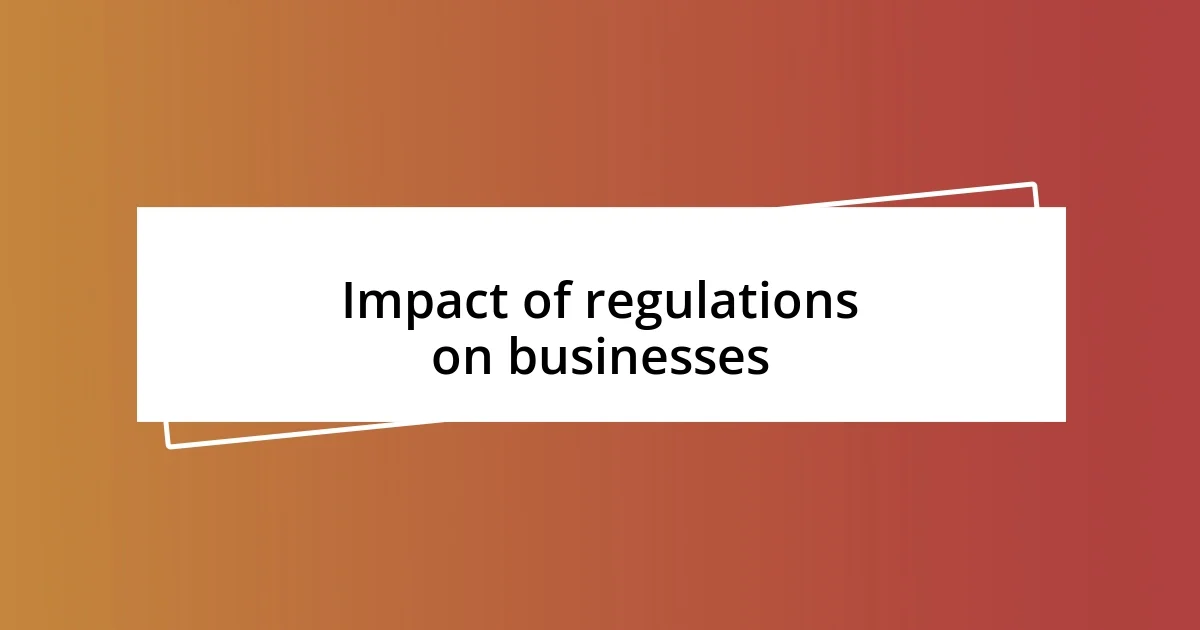
Impact of regulations on businesses
Regulations can significantly shape how businesses operate, often serving as both a challenge and an opportunity. I’ve witnessed organizations dive headfirst into adapting to new compliance measures, only to realize that these regulations can streamline operations and enhance their reputation. For instance, when my former company embraced stricter environmental regulations, we not only met compliance requirements but also cut costs by improving our energy efficiency.
Here are some key impacts of regulations on businesses:
- Cost of Compliance: Initial expenditures can be high, requiring investments in new systems or training programs.
- Innovation Drive: Regulations in sustainability can spark creativity, leading to new products or processes that benefit both the company and the environment.
- Reputation Management: Transparent compliance efforts can improve public perception and customer trust.
- Market Access: Meeting regulatory standards can open up new markets that were previously inaccessible due to strict entry requirements.
Navigating this regulatory landscape often feels like a tightrope walk. I remember attending a workshop about the latest financial regulations and thinking how this could either hinder our growth or enhance our credibility. We chose to see it as an avenue to solidify our market position. It’s all about perspective.
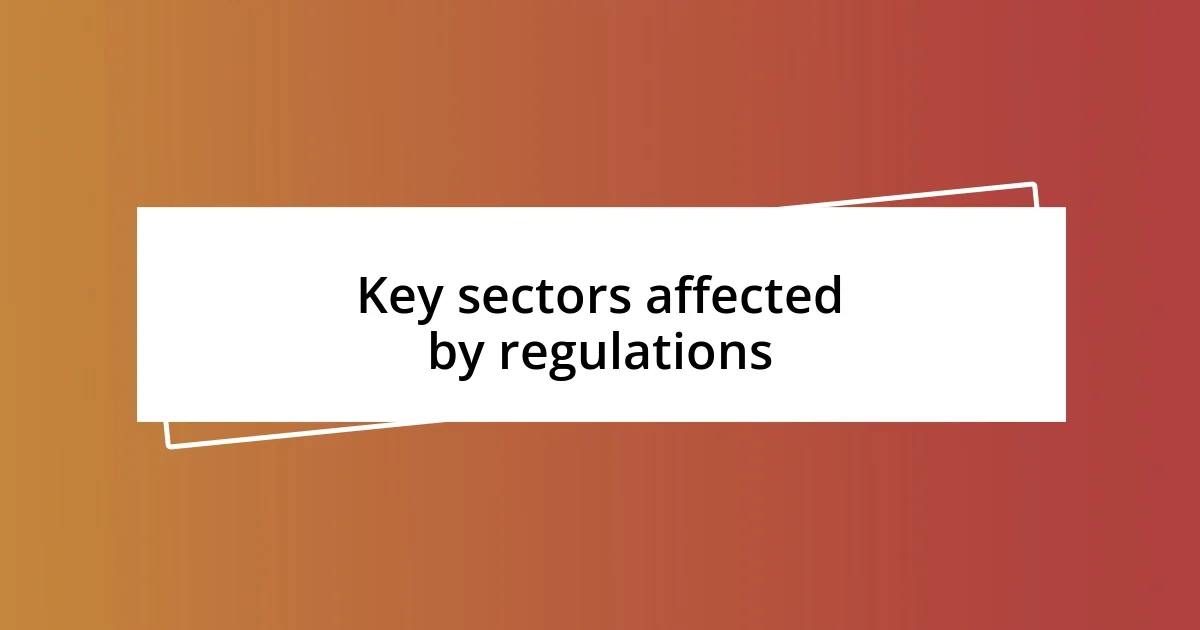
Key sectors affected by regulations
Key sectors affected by regulations span across various industries, each feeling the impact in unique ways. For instance, I remember a time when I was consulting for a tech startup facing stringent data protection laws. The anxiety was palpable. However, as they delved deeper into compliance, they discovered that enhancing their data security gave them a competitive edge. Suddenly, they weren’t just adhering to laws; they were marketing themselves as a trusted brand. The shift in perspective was transformative.
Another significant sector is the healthcare industry, which is often under the microscope for regulations concerning patient privacy and safety. I once worked with a small clinic that was wary of how regulations might stifle patient care. Yet, embracing these regulations led to improved protocols that ultimately elevated their standard of service. It’s fascinating how regulations can reshape a sector—not just to meet legal standards, but to enhance overall care and trust.
Additionally, the financial services sector faces a myriad of regulations, from anti-money laundering to fiduciary duties. In my experience, companies that treat compliance as a core value often find that it enhances their operational efficiency. I recall a financial institution I collaborated with that revised its entire risk management framework in light of new regulations. The result? Not only did they achieve compliance, but they also cultivated stronger client relationships as a result of transparency and accountability.
| Sector | Impact of Regulations |
|---|---|
| Technology | Stricter data protection laws enhance security and brand trust. |
| Healthcare | Patient privacy regulations improve service standards and trust. |
| Financial Services | Compliance enhances operational efficiency and client relationships. |
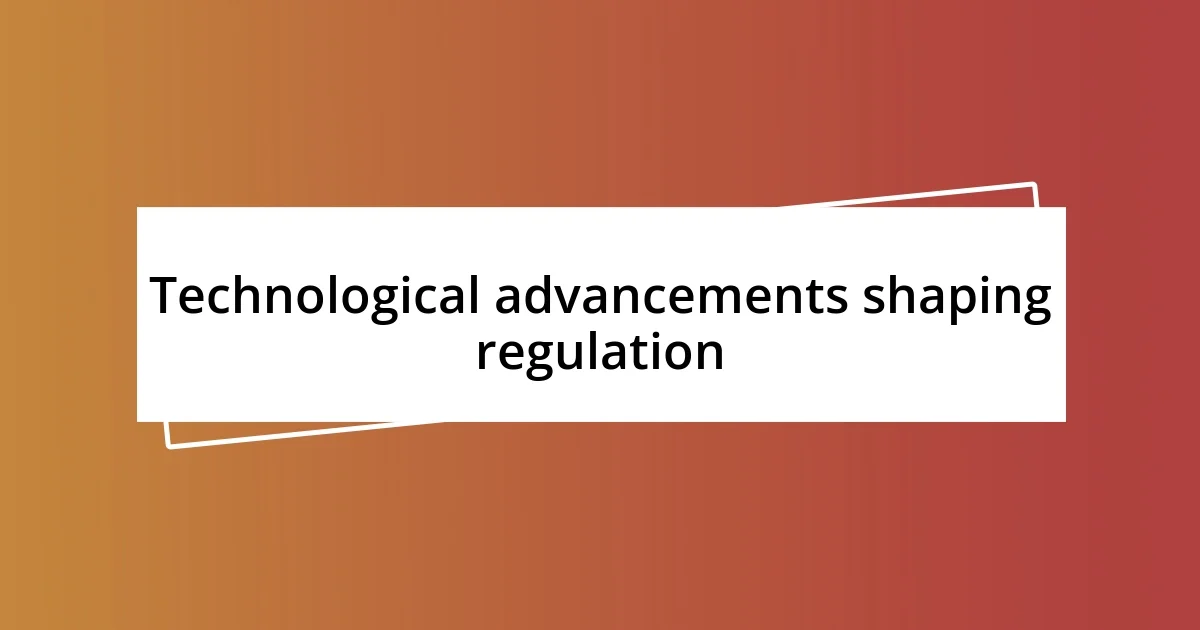
Technological advancements shaping regulation
Technological advancements are deeply intertwining with regulatory frameworks, often driving changes at an unprecedented pace. I remember attending a technology conference where a keynote speaker discussed how artificial intelligence is being harnessed for compliance. It struck me how companies are no longer just reacting to regulations—they’re using cutting-edge tech to anticipate changes and prepare proactively. Isn’t it fascinating how AI can analyze vast amounts of data to predict areas of potential compliance risk?
Moreover, blockchain technology is reshaping transparency in transactions, particularly in sectors like finance and supply chain management. I once worked with a startup exploring blockchain solutions to ensure traceability and authenticity of their products. It was impressive to see how they narrowed down potential regulatory risks simply by making their processes more transparent. This shift is groundbreaking—could this technological clarity redefine our understanding of regulatory compliance?
Finally, the rise of digital platforms for reporting and monitoring compliance is transforming how businesses manage these obligations. I recall implementing a cloud-based compliance management tool for a mid-sized firm. The ease of tracking compliance metrics not only reduced manual errors but also fostered a culture of accountability within the organization. How did we ever function without such tools? This evolution in regulation through technology is empowering businesses to be agile while maintaining compliance, and the potential for innovation is truly exciting.
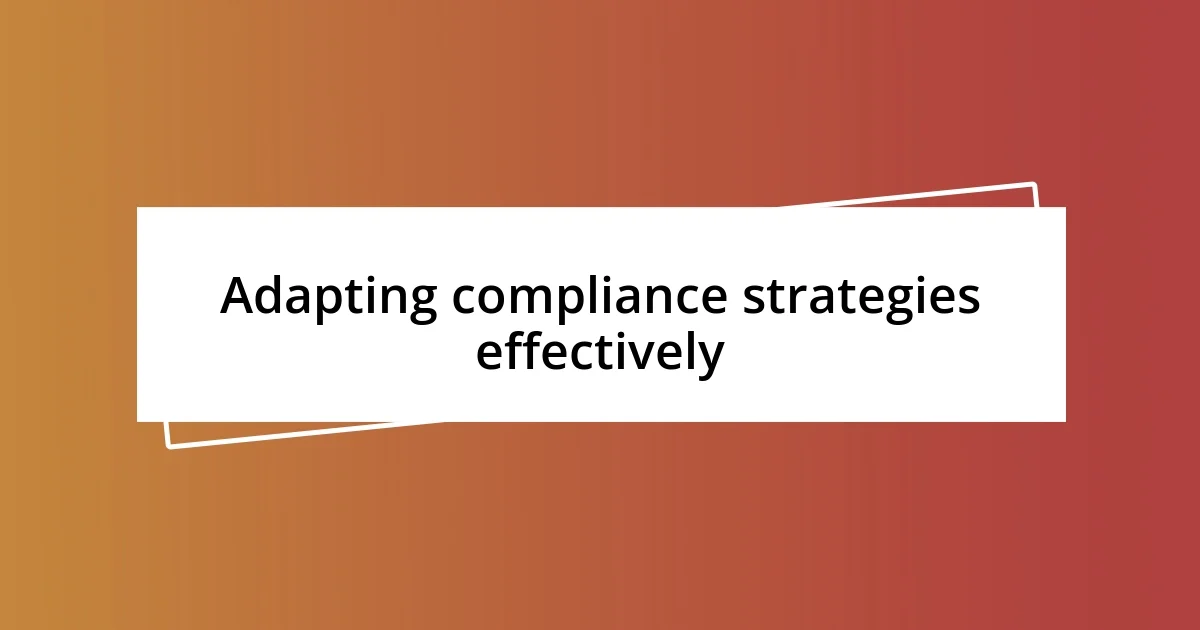
Adapting compliance strategies effectively
Adapting compliance strategies effectively requires a keen understanding of your organization’s unique landscape. In my experience, I often see companies scramble to meet regulatory requirements, but what strikes me is how successful organizations view compliance as an ongoing conversation rather than a checklist. For example, I worked with a manufacturing firm that set up regular team discussions about compliance. This proactive approach not only reduced stress during audits but also fostered a culture of ownership among employees. Have you ever noticed how collaboration encourages accountability?
It’s essential to be flexible and agile in your compliance strategy, especially as regulations continually evolve. I distinctly remember advising a retail client who initially viewed compliance as a burden. As we streamlined their processes and integrated feedback loops from each department, they realized compliance could actually lead to innovation. How transformative is that? They went from feeling overwhelmed to empowered, ultimately finding new ways to serve their customers better while still adhering to regulatory standards.
Moreover, the implementation of training programs can make a world of difference. I once facilitated a workshop for a tech company that was facing constant regulatory shifts. Through engaging training sessions, they were able to demystify the regulations and make them relatable to every employee’s role. It was rewarding to witness how this initiative boosted morale and turned compliance into a shared responsibility. Isn’t it exciting to think about how education can not only equip teams but also spark enthusiasm for compliance?
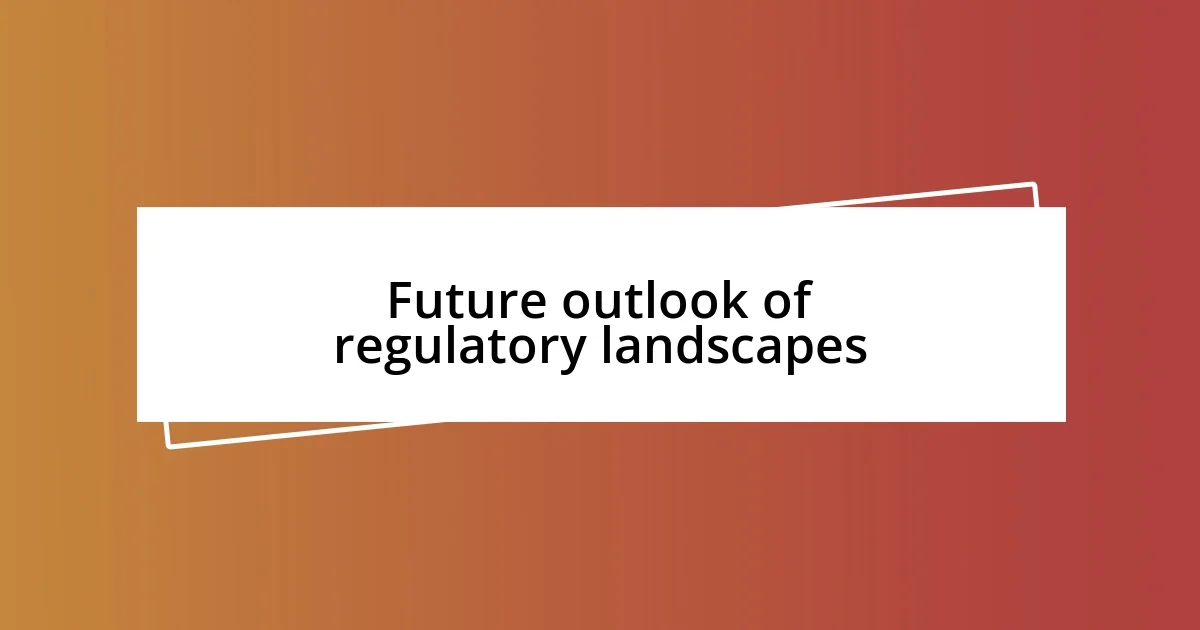
Future outlook of regulatory landscapes
The regulatory landscape is evolving rapidly, driven by technological advancements and shifting societal expectations. I recall a conversation I had with a regulatory expert who expressed concern over how quickly these changes can become overwhelming for businesses. It made me ponder: how do organizations prepare for regulations that are likely to change as public sentiment and technology evolve? One thing is clear—companies need to cultivate an adaptable mindset.
Another trend I see is the increasing emphasis on sustainability within regulatory frameworks. A few months ago, I was part of a roundtable discussion focused on environmental regulations. It struck me how some industries are already beginning to integrate sustainability into their compliance strategies, not just to meet regulations, but also to resonate with consumers. Could this be a turning point where regulatory compliance aligns with broader corporate responsibility? It’s an exciting prospect that I believe will shape the future of how businesses operate.
Finally, the advent of global regulations is presenting both challenges and opportunities for companies. I remember working with an international client who faced disparate compliance requirements across countries. Their struggle highlighted the need for a unified approach to understanding regulations that respect local nuances. How can businesses leverage this complexity to their advantage? By embracing a global mindset and fostering cross-border collaboration, I am convinced that organizations can seize new opportunities while remaining compliant in this increasingly interconnected world.

Best practices for staying compliant
Engaging with compliance means staying informed and proactive. I vividly recall assisting a financial services firm that scheduled quarterly compliance reviews, which allowed them to identify issues ahead of time rather than during audits. This habit not only created a sense of confidence within the team but really made compliance feel like a natural part of their operations. Have you ever considered how regular touchpoints could transform your compliance journey?
In my experience, leveraging technology is a game changer. One company I collaborated with utilized compliance management software that provided real-time insights into regulatory changes. The excitement in their office was palpable as they transitioned from reactive to proactive compliance. It made me think—how often does technology serve as a bridge to embracing compliance rather than viewing it as a hurdle? This shift in perspective can be incredibly empowering.
Lastly, fostering a culture of open communication is crucial. I remember a client who encouraged their employees to speak up about compliance concerns without fear of reprisal. This approach built trust and dramatically improved compliance adherence. When I reflect on this, I ask myself: why do we sometimes shy away from discussing potential issues? By creating an environment where dialogue thrives, organizations can not only safeguard compliance but also encourage continuous improvement.














